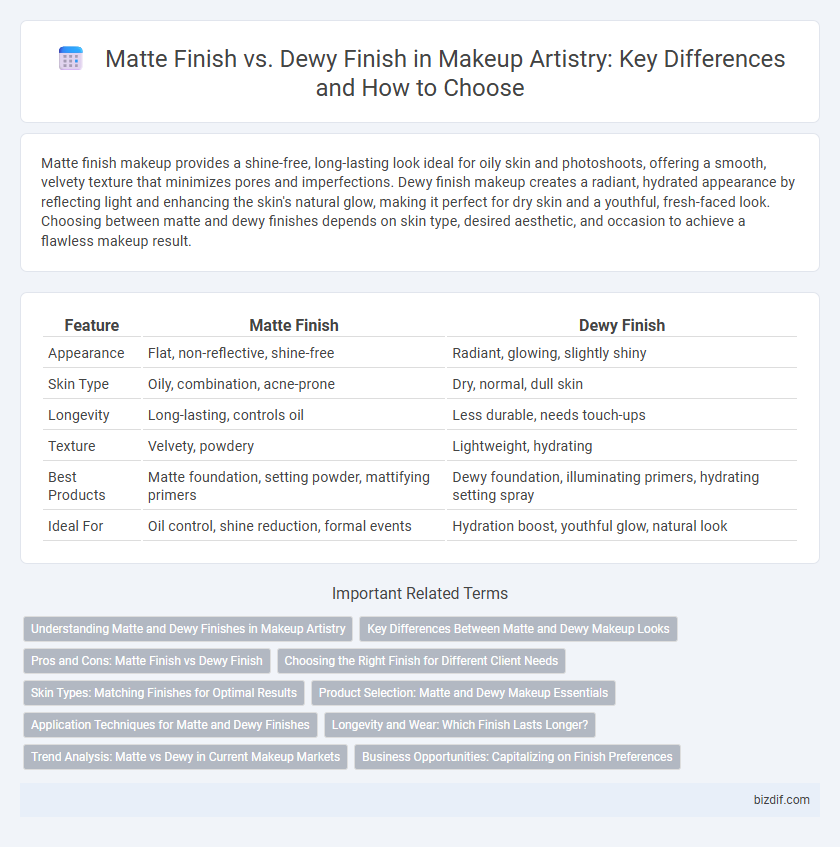Matte finish makeup provides a shine-free, long-lasting look ideal for oily skin and photoshoots, offering a smooth, velvety texture that minimizes pores and imperfections. Dewy finish makeup creates a radiant, hydrated appearance by reflecting light and enhancing the skin's natural glow, making it perfect for dry skin and a youthful, fresh-faced look. Choosing between matte and dewy finishes depends on skin type, desired aesthetic, and occasion to achieve a flawless makeup result.
Table of Comparison
| Feature | Matte Finish | Dewy Finish |
|---|---|---|
| Appearance | Flat, non-reflective, shine-free | Radiant, glowing, slightly shiny |
| Skin Type | Oily, combination, acne-prone | Dry, normal, dull skin |
| Longevity | Long-lasting, controls oil | Less durable, needs touch-ups |
| Texture | Velvety, powdery | Lightweight, hydrating |
| Best Products | Matte foundation, setting powder, mattifying primers | Dewy foundation, illuminating primers, hydrating setting spray |
| Ideal For | Oil control, shine reduction, formal events | Hydration boost, youthful glow, natural look |
Understanding Matte and Dewy Finishes in Makeup Artistry
Matte finish in makeup artistry provides a shine-free, smooth texture ideal for oily skin types and long-lasting wear, creating a flawless, velvety appearance. Dewy finish enhances the skin's natural glow with a luminous, hydrated look, popular for dry or mature skin and gaining popularity in radiant makeup trends. Mastery of matte and dewy finishes allows makeup artists to tailor looks that complement different skin textures, lighting, and event settings effectively.
Key Differences Between Matte and Dewy Makeup Looks
Matte finish makeup offers a shine-free, velvety texture ideal for oily skin and long-lasting wear, emphasizing a smooth, poreless appearance. Dewy finish makeup creates a radiant, luminous glow with a hydrated look, perfect for dry or dull skin types seeking a fresh, youthful complexion. The key difference lies in texture and light reflection: matte absorbs light for a flat look, while dewy reflects light, enhancing natural luminosity.
Pros and Cons: Matte Finish vs Dewy Finish
Matte finish makeup offers long-lasting oil control and a smooth, shine-free appearance, making it ideal for oily skin types or humid environments, but it can emphasize dry patches and may appear flat on mature skin. Dewy finish provides a radiant, youthful glow and enhances skin's natural luminosity, benefiting dry or dull complexions, yet it may highlight imperfections and is prone to shine in combination or oily skin. Choosing between matte and dewy finishes depends on skin type, desired look, and the occasion's lighting conditions.
Choosing the Right Finish for Different Client Needs
Matte finish makeup provides a shine-free, long-lasting look ideal for clients with oily skin or those seeking a polished, photo-ready appearance. Dewy finish enhances natural radiance with a luminous, hydrated effect perfect for dry or mature skin, offering a youthful glow. Selecting the appropriate finish depends on skin type, desired look, and event lighting conditions to ensure client satisfaction and flawless results.
Skin Types: Matching Finishes for Optimal Results
Matte finish makeup suits oily and combination skin by controlling shine and minimizing pores, creating a smooth, oil-free appearance. Dewy finish is ideal for dry and mature skin, providing hydration and a luminous glow that enhances natural radiance. Selecting the right finish based on skin type ensures optimal wearability and a flawless, personalized look.
Product Selection: Matte and Dewy Makeup Essentials
Matte makeup essentials typically include oil-free foundations, setting powders, and mattifying primers designed to control shine and provide a long-lasting, smooth finish. Dewy makeup products often feature hydrating foundations, illuminating primers, and cream-based highlighters enriched with light-reflecting particles to create a radiant, glowing complexion. Selecting the right product depends on skin type and desired look, with matte formulas ideal for oily skin and extended wear, while dewy products suit dry skin and emphasize luminosity.
Application Techniques for Matte and Dewy Finishes
Matte finish application involves using oil-free primers and setting powders to create a shine-free, velvety texture often achieved with dense, stippling brushes for even coverage. Dewy finish technique requires hydrating primers and luminous foundations applied with damp sponges or fingers to enhance natural glow and skin radiance. Strategic use of highlighters on high points of the face, such as cheekbones and brow bones, intensifies the dewy effect.
Longevity and Wear: Which Finish Lasts Longer?
Matte finish makeup typically offers superior longevity due to its oil-absorbing properties, making it ideal for oily skin and extended wear throughout the day. Dewy finish makeup provides a radiant, hydrated look but tends to wear off faster, especially in hot or humid conditions, requiring more frequent touch-ups. Choosing between matte and dewy depends on skin type and desired durability, with matte finishes generally lasting longer under various environmental factors.
Trend Analysis: Matte vs Dewy in Current Makeup Markets
Matte finish remains a staple in professional makeup artistry for its long-lasting, oil-absorbing properties favored in high-definition settings, especially in hot or humid climates. Dewy finish gains traction within social media beauty trends due to its luminous, skin-like glow that appeals to younger audiences seeking a fresh, hydrated look. Current makeup markets reveal a balanced demand with product innovation focusing on hybrid formulas that combine matte longevity with dewy radiance to meet diverse consumer preferences.
Business Opportunities: Capitalizing on Finish Preferences
Matte finish products appeal to clients seeking long-lasting, shine-free looks, creating opportunities for businesses to market oil-control and pore-refining solutions. Dewy finish products attract consumers desiring a radiant, youthful glow, driving demand for hydrating foundations and illuminating highlighters. Offering both finishes allows makeup artists and brands to diversify their product lines, cater to varied client preferences, and increase market reach.
Matte finish vs Dewy finish Infographic

 bizdif.com
bizdif.com